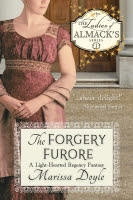When I lived in London, I walked past Coram’s Fields every day. It’s a beautiful park with a fountain, an urban farm (the sheep always look grimy, but London is a highly polluted city!), a ton of open space, and high gates. Most enticing of all to a curious adult is the sign saying, NO ADULTS UNLESS ACCOMPANIED BY A CHILD. I had to find out more, and since I didn’t know any children I could borrow at the time, it had to be theoretical research.
 After basic details about the current park (www.coramsfields.org/), I learned that Coram’s Fields stands on the site of the old London Foundling Hospital – not a hospital in the modern sense of the word, but a charity orphanage. In the 1730s, sea captain, merchant, and philanthropist Thomas Coram became appalled by the number of homeless, dying, and dead children on the streets of London. There was no institution in England doing anything for illegitimate children – the usual reason for abandoning an infant to the workhouse or the streets. Coram persuaded George II to grant him a Royal Charter to establish a “hospital for the maintenance and education of exposed and deserted young children”. In 1741, the London Foundling Hospital opened in a temporary house and began accepting children. (Image above from the Foundling Hospital's website, http://www.foundlingmuseum.org.uk/)
After basic details about the current park (www.coramsfields.org/), I learned that Coram’s Fields stands on the site of the old London Foundling Hospital – not a hospital in the modern sense of the word, but a charity orphanage. In the 1730s, sea captain, merchant, and philanthropist Thomas Coram became appalled by the number of homeless, dying, and dead children on the streets of London. There was no institution in England doing anything for illegitimate children – the usual reason for abandoning an infant to the workhouse or the streets. Coram persuaded George II to grant him a Royal Charter to establish a “hospital for the maintenance and education of exposed and deserted young children”. In 1741, the London Foundling Hospital opened in a temporary house and began accepting children. (Image above from the Foundling Hospital's website, http://www.foundlingmuseum.org.uk/)It must have been a tragic process: parents brought their children, usually babies under one year old, along with a distinguishing item - a trinket, ribbon, or meaningful scrap of writing – that was kept with the child’s record in case the parent came back to reclaim the child. I can’t help imagining a parade of destitute adults, hoping to give their children a decent chance at life by giving them up (maybe temporarily) to the Foundling Hospital.
The demand for the Hospital’s services was enormous – so much so that it was forced to turn away unknown numbers of children. In 1756, the House of Commons resolved that all children should be accepted – not just from London, but all over the country. Over the next four years, almost 15,000 children flooded into the Hospital, sending the House of Commons into a panic because of the expense.
With this many children, and this much anxiety over the cost of raising them, there followed trauma. Many children suffered at the hands of irresponsible wet-nurses and cruel employers, to whom they were apprenticed at 12 or 14. Others died from diseases – inevitable in the period, but probably exacerbated by such a dense child population. Occasionally, there was scandal: Elizabeth Brownrigg was a midwife who so mistreated her apprenticed servant girls that one died of the beatings and neglect received at Brownrigg’s hands. While this forced the Foundling Hospital to review its policies and the sorts of people to whom it sent orphans, it was far too late for many: of the almost-15,000 admitted between 1756 and 1760, just 4,400 lived to adulthood.
Over time, the Foundling Hospital attracted celebrity patrons, including composer Georg Frideric Handel and artist William Hogarth. With more money came better living conditions for the children, and it weathered the nineteenth century without major scandal. Yet it couldn’t hope to accept every homeless child in London. From what I’ve been able to learn, it still admitted mainly infants, which would exclude a child like my heroine, Mary Quinn, who loses her mother when she’s seven or eight.
The Hospital still exists today. It’s no longer in London – it moved to the countryside in the 1920s – but it leaves Coram’s Fields as a physical reminder of its existence, and of the tragic sights that inspired Thomas Coram.
Thank you, Ying! It's been a pleasure having you here!
Y.S. Lee is the author of the Agency books: The Spy in the House, The Body at the Tower, and The Traitor in the Tunnel, all from Candlewick Books.





1 comment:
What an interesting post! Thanks for sharing your information.
Post a Comment